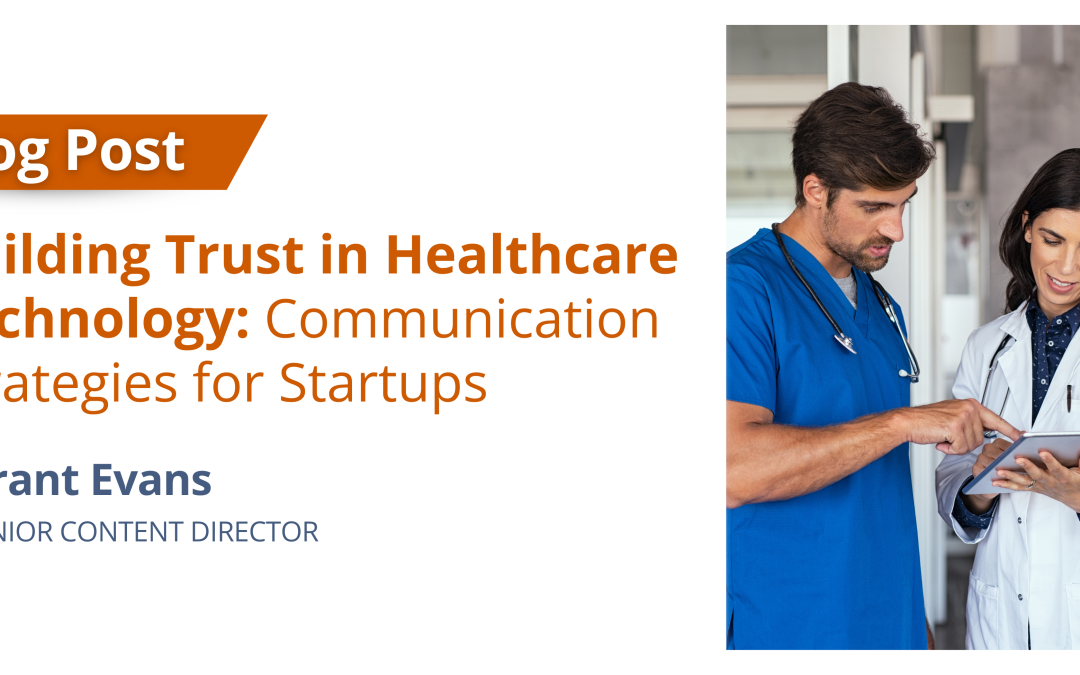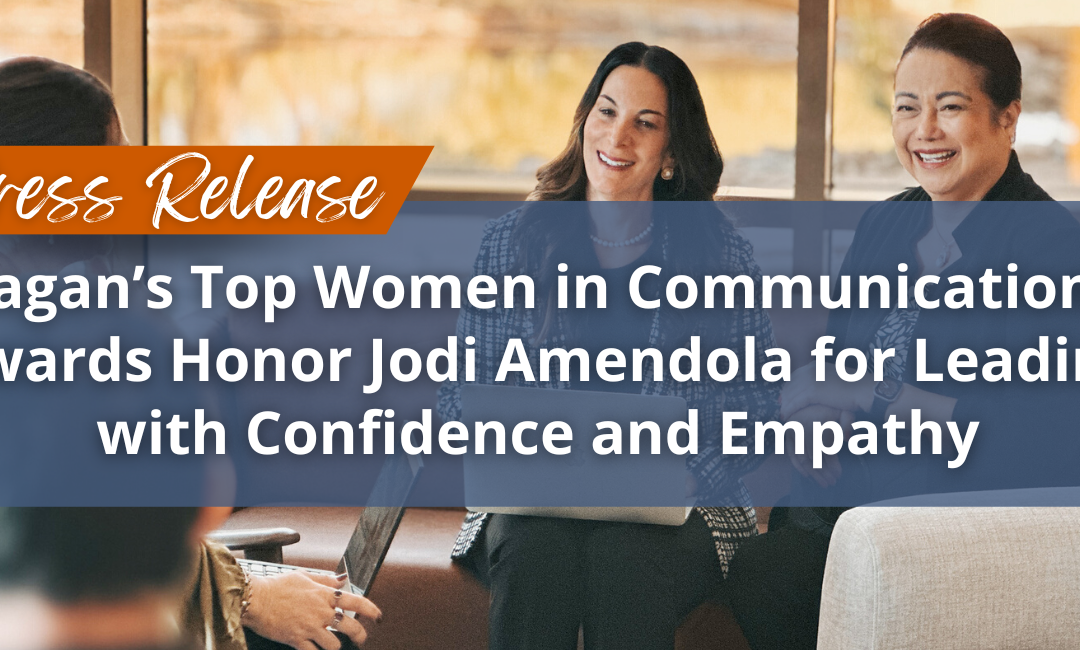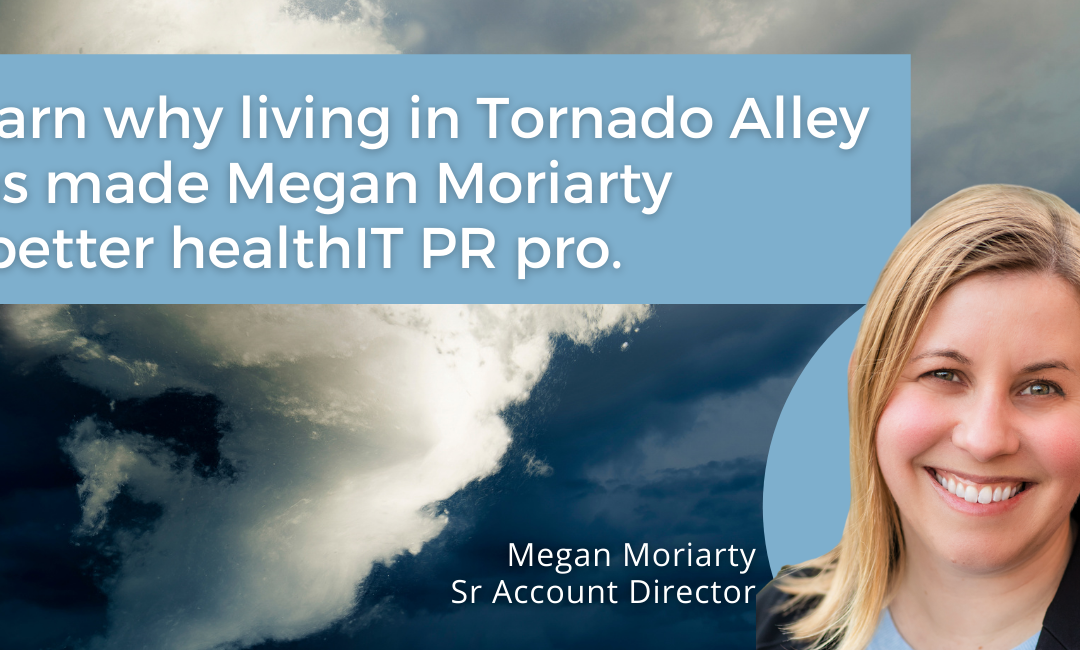
by Grant Evans | Mar 19, 2025 | Blog
In healthcare technology, trust isn’t just a marketing goal—it’s the foundation of success. While established healthcare brands leverage decades of reputation, startups face the unique challenge of building credibility from scratch in a sector where mistakes can have serious consequences.
Leveraging Expertise Strategically
Your team’s credentials and experience are your first trust-building assets. However, many health tech startups underutilize these valuable proof points. Beyond simple bio pages, consider developing thought leadership content that showcases your team’s deep understanding of healthcare challenges and solutions. Regular blog posts, whitepapers, and speaking engagements help position your experts as reliable voices in the field.
Data-Driven Credibility
Original research and survey data are powerful trust-building tools. Consider conducting annual industry surveys that explore healthcare technology trends, challenges, and adoption patterns. This primary research can fuel an integrated content strategy:
- Transform survey insights into comprehensive ebooks and whitepapers
- Create press releases highlighting key findings for media coverage
- Develop social media campaigns featuring data points and infographics
- Gate premium content to capture leads while building authority
- Use data points in media pitches to secure coverage and commentary opportunities
This approach positions your startup as a knowledge leader while generating valuable marketing and PR opportunities. Media particularly value exclusive data, making your startup a go-to source for industry insights.
Establishing Partnerships
Strategic partnerships with established healthcare institutions can significantly accelerate trust-building. Whether it’s pilot programs with hospitals, research collaborations with medical schools, or integration partnerships with established health tech platforms, these relationships signal credibility to your target market.
Many successful health tech startups begin by focusing on a single respected partner, perfecting their solution in a real world environment before expanding. This approach provides valuable case studies and testimonials—essential tools for building broader market trust.
Demonstrating Compliance and Security
In healthcare, compliance isn’t just about checking boxes—it’s about protecting patients. Clear communication about your regulatory compliance status, security measures, and data protection protocols is crucial. Consider creating dedicated security and compliance content hubs that explain complex requirements in accessible terms.
Be transparent about your current stage and future roadmap. If you’re still working toward certain certifications, communicate your progress and commitment to meeting industry standards.
Creating Evidence-Based Content
Healthcare decisions require solid evidence. Develop content that demonstrates both your solution’s effectiveness and your understanding of healthcare’s complexities. This might include:
- Detailed case studies with measurable outcomes
- Research collaborations and clinical validation studies
- Regular analysis of healthcare trends and challenges
- Clear explanations of your technology’s scientific foundation
Building Media Relationships
Focus on building relationships with healthcare technology journalists and influencers before you need coverage. Provide them with genuine insights, exclusive data, and expertise, not just company news. When you do have news to share, these established relationships will help ensure more informed, credible coverage.
Leveraging Agency Expertise
For many health tech startups, partnering with an experienced communications agency can accelerate trust-building efforts. The right agency brings established media relationships, content development expertise, and integrated campaign experience. They can coordinate media and analyst relations while developing compelling content that showcases your expertise.
However, success requires more than just hiring an agency. Designate a dedicated in-house resource to serve as the primary liaison. This person should facilitate content approvals, coordinate subject matter expert interviews, and monitor industry developments that could fuel new content or media opportunities. This partnership approach ensures your agency can execute effectively while maintaining alignment with your company’s goals and expertise.
The Long Game
Trust in healthcare technology isn’t built overnight. A consistent, multi-channel approach focused on expertise, evidence, and transparency will gradually establish your startup as a credible player in the healthcare ecosystem. Remember, in healthcare technology, trust isn’t just about marketing—it’s about demonstrating your commitment to improving patient outcomes and advancing healthcare delivery through validated, data-driven approaches.

by Administrator | Jan 16, 2024 | News
Amendola Communications founder and CEO an honoree in the Leaders category for breaking new ground in healthcare, health tech public relations and marketing
SCOTTSDALE, Ariz., Jan. 16, 2023 – Jodi Amendola, CEO and founder of Amendola, a nationally recognized, award-winning healthcare technology and life sciences public relations and marketing firm, is an honoree in the 2023 Ragan’s Top Women in Communications Awards in the Leaders category.
The prestigious awards program honors the outstanding women who have redefined the boundaries of communications, shining a spotlight on their exceptional achievements and celebrating their valuable contributions to the industry. The Leaders category recognizes inspiring women who lead with confidence and empathy and have earned the admiration of their teammates.
Jodi Amendola is a pioneer in healthcare, health IT, and life sciences public relations and marketing. Twenty years ago, her mission to improve healthcare led her to start her own agency, Amendola Communications. She has grown the agency to a team of 25 account directors, media relations and social media pros, writers, and execs who are known in the market as the “A-Team” for the stellar client service and exceptional, measurable results they achieve for the agency’s 50 clients.
“I’m honored to be recognized by such a prestigious awards competition,” Amendola said. “On a personal note, I would like to extend my gratitude to all the women who have played essential roles in my own career development, serving as mentors, coaches, friends, and advocates. I’ve taken those learnings to build an organization of senior-level team members who are proud of the work they do, and clients who keep coming back because of the results we achieve for them. In fact, nearly 90% of our client base represent multi-year and repeat clients.”
Ragan will honor the women making the list at a special awards gala in New York City on Feb. 28 and in special editorial programming.
The award marks a great showing for the agency during the past year. In 2023, Amendola won two Platinum awards and one Gold in the Public Relations category of the MarCom Awards, one of the largest international creative competitions in the world. The agency also was honored recently in Ragan PR Daily’s Content Marketing Awards’ Agency of the Year, which recognizes the most effective and productive teams in public relations and marketing.
About Amendola
Amendola is an award-winning, insights-driven public relations and marketing firm that integrates media relations, social media, content and lead gen programs to move healthcare, life sciences/pharma and healthcare IT decision-makers to action. The agency represents some of the industry’s best-known brands as well as groundbreaking startups that are disrupting the status quo. Nearly 90% of its client base represents multi-year clients and/or repeat client executives. Amendola’s seasoned team of PR and marketing pros understand the ongoing complexities of the healthcare ecosystem and provide strategic guidance and creative direction to drive positive ROI, boost reputation and increase market share. Making an impact since 2003, Amendola combines traditional and digital media to fuel meaningful and measurable growth. For more information about the industry’s “A-Team,” visit www.acmarketingpr.com, and follow us on Twitter and LinkedIn.
Media Contact:
Marcia G. Rhodes, mrhodes@acmarketingpr.com
# # #

by Megan Moriarty | Jan 5, 2022 | Blog
One of the foundational PR rules that any communications professional learns is to avoid the use of jargon – the technical terminology or characteristic idiom of a special activity or group, as defined by Merriam-Webster. In my years working in PR for healthcare and health IT organizations, this has been a permanent item on my list of interview tips, and any media training I’ve conducted has included guidance to avoid the use of jargon.
When communicating to a general audience, this is sound guidance and standard practice. Jargon is unnecessarily complicated, can confuse your audience and cause your audience to lose interest. If your audience has tuned out because they don’t understand what you’re telling them, they won’t hear or read your message.
It may be tempting to include technical language to demonstrate proficiency and credibility with particular subject matter. This is an especially tricky trap for those of us who work in specialized areas like healthcare and health information technology. But there’s a fine line between using familiar terms and wading into the murky waters of jargon.
As with any marketing content, one size does not fit all. Public relations and marketing must be specific to your audience. Using technical language can demonstrate competency and help build credibility, if the audience can understand it. That’s why it’s crucial to do your homework, research your audience and their level of understanding.
Get to Know Your Audience
In a recent Amendola Communications blog post, my colleague Jack O’Brien reminded us that PR representatives should take time to do their research on the journalists and outlets that they’re pitching. Not only will this help you target your pitches to topics of interest, but it will also help you tailor your language to the journalist’s readers and the publication’s audience.
This is especially true for any media relations professionals who work in a specific industry, as we do at Amendola Communications. We work with a variety of reporters – from those who write for publications focused on a specific medial specialty, to trade reporters with a deep focus on health IT, to healthcare beat reporters at major national publications, to general assignment reporters at daily newspapers. The audience and level of understanding for each of these reporters and publications will be different, and so should each pitch. As you can see, one size definitely does not fit all.
Write in a Manner the Audience Will Understand
Once you’ve done your homework and you understand your audience, you should also delve into their level of familiarity and understanding of the topic you’re pitching. For example, if a publication targets physician executives, you can safely assume the audience will understand basic medical terminology because of their medical education. A physician discussing cardiovascular health can thus feel confident that the audience will understand the term “myocardial infarction.
However, if that same physician is instead speaking to the general public about heart health, it would be more appropriate to use the more colloquial and widely understood term “heart attack.” A good rule of thumb when pitching to and writing for a general audience is to avoid using language that your Aunt Sally wouldn’t understand.
Always Keep the Reader in Mind
I’ll offer some sage advice that one my college professors, Steve Kopcha, shared from his decades of experience in strategic communications: “Say it square, then say it with flair.”
It’s easy to get so caught up in figuring out how to “say it with flair” that we forget to first “say it square.” In the simplest terms that Aunt Sally would understand, how can you communicate what your client’s product or service does? What problem does it help to address? Why does this matter for the reader?
A former communications colleague of mine who had spent years as a local news reporter offered a helpful way to frame this concept. She would ask me how I’d explain something to my next-door neighbor, and why it would matter to them. When you find yourself struggling with whether to use technical language, ask yourself what it will mean to the person reading the article you’ve pitched. Will it help further their understanding, or does it muddle your message? Keeping the reader in mind will help you to walk that fine line between technical language that helps to inform and jargon that muddles your message.

by Jodi Amendola | Oct 27, 2021 | Blog
At the time, I did not realize we were so innovative. When I founded the agency in 2003, it was clear to me that with the Internet, email, phones, and the nature of our public relations and marketing communication services, not everyone needed to be in the same office all the time. I also recognized that I could more easily attract and retain the best talent for our agency – whether they were in California, Texas, Massachusetts or North Carolina – by not forcing them to relocate to our office in Scottsdale, Arizona.
In 2021, our agency looks prescient considering most of my staff have always worked from their homes. In reality, at the time, I was just doing what was best for my business. To this day, though, employee after employee tells me that the choice to work from home, not uprooting their families and starting a new life in a new town, was a major attractive feature in joining our agency.
As the COVID-19 pandemic continues throughout most of the country—and survey after survey show how much employees prefer to work from home—some employers are considering that they may need to loosen their policies to allow more team members to work from home. Although it might make it harder for our agency to compete for talent, I would encourage you to do it. Here’s how to make work from home work for your company:
- Set Clear Expectations
Like all businesses, our agency runs on deadlines. Whether it is an article, press release, white paper or PR plan, having clear, accountable deadlines ensures that the distractions of working from home do not detract from productivity.
Another expectation we have is accessibility and responsiveness. We offer flexible schedules as long as the work gets done and clients are happy, but when a member of our team says they will be in their office, we expect that they will indeed be available either by email, phone or for web meetings. That availability is important for internal communication, but it is even more crucial to better serve our clients. Being available and responsive to them must always be the top priority during work hours.
2. Communicate, communicate, communicate
Although many companies use Slack and other business communication platforms, our team has still found email to be the most effective and easiest way to stay in touch with each other on a daily basis. Of course, we have plenty of phone calls and web conferences, but the bulk of our daily communication runs on email.
Once again, if one of our clients wants to use a business communication platform, our account teams happily use that method. The key is the consistency of communication and setting the expectation of a prompt response during a team member’s regular schedule.
3. Show Me the Schedule
Our account teams do a lot of writing, editing, and strategic planning, which is much easier without the distractions and interruptions of email and meetings. We also do not want to disrupt any of their client meetings with our internal questions or calls.
For these reasons and others, our account teams make their schedules public so their managers and colleagues can visualize their availability. Other than client meetings, our teams also make sure to block time in their schedule for writing, editing or creating a presentation. Blocking a schedule sends a message like an office door being open or closed. As a colleague, you know what it means when you see it.
4. Company-Wide Meetings Are a Must
Although the actual time seems to constantly change, our agency still meets regularly on a web conference to talk about agency updates, share success stories and best practices and even feature guest speakers. To keep it fun, we compile positive feedback that team members have received from clients or colleagues and share them. We also have a drawing where a positive comment is drawn at random and the person receiving the compliment wins a gift card. We call it our “kudos” drawing and it is always an uplifting way to close a meeting.
5. Check-in Regularly
Every six months, we have a formal check-in where a manager will talk with a team member about their work, accomplishments, challenges and solicit feedback to find out how we can improve as an agency. Since we are still relatively a small company with 25 team members, I also still check in with people I haven’t spoken to in a while on a more personal level to see how they are feeling about work, their life and if we can support them in any way. Since we can’t have impromptu “water cooler” or coffee machine moments, these random check-ins help nurture a sense of closeness and camaraderie that is difficult to cultivate when we don’t see each other in person as often.
A bonus tip: If your work-from-home team feels comfortable traveling, have a company-wide retreat either once a year or every couple of years, depending on your company’s size and budget. It is always rewarding when we can get together in a fun location, enjoy meals and learn from each other. The fact that we so rarely get to see each other in person makes the retreats especially meaningful for our team.
So whether you plan to bring all, some or none of the team back to the office once the pandemic is under control, I recommend instituting an option to work from home, if it is feasible for your company. Our teams appreciate the perk and show it to us every day in their high quality of work and client service.

by Megan Moriarty | Jul 21, 2021 | Blog
Most people working in communications are familiar with the idea that storytelling creates the most impactful and memorable messages. Feeling a human connection to a story is what makes it resonate with us, and what makes us care. Working in the healthcare communications field makes it easy to tell great stories because we’ve all had our own healthcare experiences. Healthcare is personal and we can relate to any number of situations because of that.
When pitching/covering/writing about health IT, it’s important to center around the human element. Amendola CEO Jodi Amendola has shared that the best PR is personal, and the human connection is what makes any story relatable. My colleague Margaret Kelly also recently wrote about her perspective on health IT as a patient. Connecting the features of health tech to end users (physicians and other care providers) and to the ultimate benefits to patients makes stories more powerful and demonstrates the value of technology.
In the health IT world, there’s so much innovation and so many new tools, programs and systems that can improve the healthcare system. But the most important stories in health IT are not about the technology but instead about the patients who ultimately benefit from the technology. Patients are the ultimate beneficiary of all the innovation happening in healthcare, from safety, to efficiency, to patient satisfaction and ultimately improved health outcomes.
If, like me, you’ve had a telemedicine appointment this year because of COVID-19, you’ve experienced health tech innovation firsthand. While telehealth was not initially conceived as a method for delivering health care to prevent viral spread during a pandemic, it’s an unexpected use case for an innovation that was originally thought of as a convenience. The rapid adoption of telemedicine during the COVID-19 pandemic has likely changed health care delivery, and telemedicine is likely here to stay in a bigger role moving forward.
I can look at my own career in PR and see real-world examples of how healthcare technology benefitted physicians and patients in unexpected ways. I live in the Kansas, which is right in the heart of “Tornado Alley.” No, I’ve never actually seen a tornado, but the sirens are a familiar part of spring and summer in the Midwest. Tornados are destructive and can be deadly – you may remember the horrific destruction of the EF-5 tornado in Joplin, Missouri in 2011 which killed 161 people and badly damaged the local hospital.
Even though there were reports of X-ray films being blown 70 miles away, patient records were also digitized. When the hospital was closed due to the extensive damage, the community set up temporary facilities to care for patients and the clinicians were able to electronically access medical records for those patients. Prior to the widespread adoption of electronic health records, this would not have been possible.
I was also working in health IT when a devastating tornado ripped through a medical center in Oklahoma in 2013. The roof was torn off and the medical center had to evacuate patients to other locations within the regional health system. Before EHRs, this situation would have left clinicians without access to the health records for the patients in their care. But thanks to the digitization of medical records and a regional health information organization (RHIO) for which my employer remotely hosted the records, patients could be transferred to other nearby facilities and physicians could access patients’ records for treatment.
This second example was actually a cover story in Modern Healthcare that highlighted how technology makes our healthcare system better and benefits communities and patients. It may have been an unintended use case for health information exchanges (HIEs) and remotely hosted records for disaster preparedness, but sometimes unforeseen events help to prove the efficiency and value of certain innovations.
Finding a meaningful way to communicate how innovations benefit people makes health IT messages more memorable. To make your health tech story resonant with audiences, always look for the human connection.





